 |
|
Here and There introduces art, artists, galleries and museums around Japan that non-Japanese readers and first-time visitors may find of particular interest. The writer claims no art expertise, just a subjective viewpoint acquired over many years' residence in Japan.
|
|
 |
|
|
 |
 |
Hake-no-Mori: Tokyo's Fertile Crescent
Alan Gleason |
 |
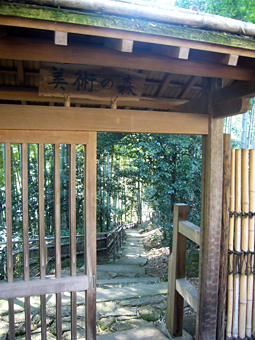 |
|
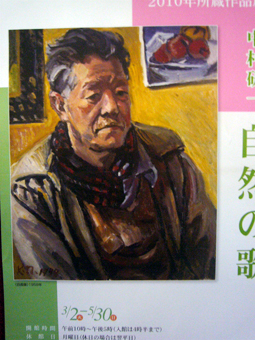 |
| An enticing stairway leads down the hake from the gate to the Bijutsu-no-Mori (Art Forest) above the Hake-no-Mori Museum. |
|
Ken'ichi Nakamura, "Self-Portrait" (1958), featured on a poster for the current exhibition (2 March - 30 May 2010) at the Hake-no-Mori Museum. |
Out in the suburbs west of Tokyo is a curious geological formation, a steep bluff that runs for about 20 kilometers along the southwest edge of the Musashino Terrace above the Nogawa, a small tributary of the mighty Tama River. Geologists have named this escarpment the Kokubunji Cliff, but locals call it the hake, a word that literally means "drainage" but here refers to the abundant springs found along the bottom of the bluff.
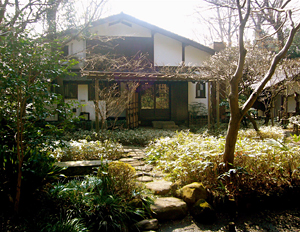 |
The former Nakamura home (now the Oven Mitten Cafe)
and garden behind the museum. |
One of the most fertile spots anywhere in Japan, the land along the hake has been inhabited for at least 27,000 years. So rich was this area in water, fish and edible plants that well into the Neolithic era, its residents were able to lead the sedentary lives typical of agricultural communities -- but without having to do any farming to speak of.
In more recent times the narrow strip of land between the bluff and the Nogawa has been cultivated for rice as well as wasabi, which thrives on the pristine spring water from the hake. Thanks to the steepness of the dropoff, human dwellings never occupied the slope itself, and even modern developers have shied away from it. Today it remains a fiercely protected greenbelt cutting through the gray urban sprawl of Tokyo, the heart of a string of beautiful parks without which these suburbs would be a bleak place indeed.
There is no better spot to enjoy the tranquility of the hake than the Hake-no-Mori (Hake Forest) Museum in Koganei City. Set in a glade at the foot of the bluff, the museum is dedicated to the work of Ken'ichi Nakamura (1895-1967), a western-style oil painter of some repute who moved here from downtown Tokyo after losing his studio in the firebombings during the last days of World War II. Built on the site of Nakamura's studio in 1989 and donated by his family to the city of Koganei in 2004, the museum houses paintings, drawings and ceramics by Nakamura and his contemporaries.
Behind the museum, however, is what may be Nakamura's most enduring legacy: the Bijutsu-no-Mori (Art Forest). This is where Nakamura built his home and a landscaped garden of ponds and paths extending all the way up the hillside. Tastefully combining Japanese and western motifs in a simple, economical layout (dictated by the privations of wartime, when building materials were hard to come by), the house now serves as the Oven Mitten Cafe, whose sunny tables and large windows look out on the garden and the surrounding bamboo groves. Offering light repasts of quiche, salad and delicious homemade bread and pastries, the cafe is the perfect place to enjoy the beauty of the hake at leisure.
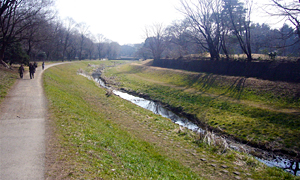 |
The Nogawa flows for miles through pastoral scenery
like this in Nogawa Park, west of downtown Tokyo.
|
A short stroll downhill along one of the rivulets that course out of the bluff leads to the Nogawa, which flows for miles through a seemingly endless expanse of fields, parks and playgrounds. Following the river downstream takes you through Musashino Park and then into the larger Nogawa Park. Atop the bluff here, archaeologists have found museums-full of large, ornately decorated earthen jars and other implements created by the Jomon people, who lived here between 14,000 and 400 BCE.
While the Hake-no-Mori Museum does not have an archaeological collection, there are other museums in the area that do. Two of the finest collections of Jomon pottery anywhere can be found at the Hachiro Yuasa Memorial Museum on the campus of International Christian University, situated above Nogawa Park and the site of some of Japan's most bountiful Jomon diggings, and the Edo Tokyo Open Air Architectural Museum, located in Koganei Park a couple of miles north of the hake. Both institutions provide a wealth of information on the geography of this fascinating region, as well as on the lives of the people who have lived in this fertile crescent -- now an oasis of green hemmed in on all sides by an ever-expanding metropolis -- for so many millennia.
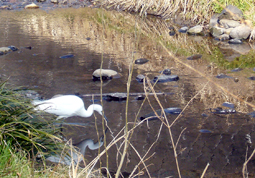 |
 |
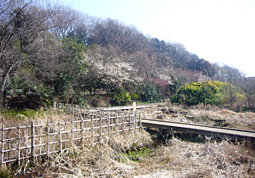 |
An egret fishes -- or admires its reflection -- in the Nogawa.
|
 |
Early-blooming ume (Japanese apricots) at the foot of the hake, with fallow rice paddies below.
All photos by Alan Gleason
|
|
|
|
|
|
|
 |
 |
Alan Gleason
Alan Gleason is a translator, editor and writer based in Tokyo, where he has lived for 25 years. In addition to writing about the Japanese art scene he has edited and translated works on Japanese theater (from kabuki to the avant-garde) and music (both traditional and contemporary). |
|
|
|
 |
|